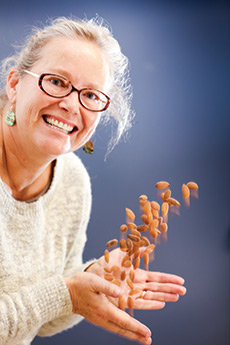Almonds blossoming

Dr Michelle Wirthensohn Virtually no-one outside the almond industry blinked when Australia overtook Spain as the world’s number two exporter last year. But South Australians certainly should have taken notice, with the humble nut set to join the olive and the grape as a great new cash crop for the State.
This year’s crop is expected to top out at a record 75,000 tonnes, with room for growth as international demand expands. This is due to the ongoing drought reducing California’s yield, which normally accounts for 80 per cent of world output.
The $370 million almond export industry is already a second-generation success in South Australia, with growers expanding from original plantations around Adelaide into the Riverland. And it is likely to grow faster and further, if research led by the University to create an almond that is especially suited to Australia succeeds.
Almonds are a good source of protein, plus Vitamin E, heart disease risk-reducing monounsaturated fat and dietary fibre. Almond meal also meets the increasing market gluten-free foods. Recent US research also points to the almond’s potential in preventing the onset of diabetes. “Almonds are the quiet achiever of horticulture,” says Dr Michelle Wirthensohn, Horticulture Innovation Australia Research Fellow at the University’s Waite Research Institute.
Also in the pipeline is a research project on almond waste, investigating the use the shell in cancer treatment and as an organic feed additive for fish and abalone.
It’s why Dr Wirthensohn, by her own admission, “lives and breathes almonds”—she is currently working to discover if new tree breeds can create a super SA nut. “At the moment there are only three cultivars, so we need to develop more for long-term sustainability,” she says. Of the five varieties in large-scale trials in the Riverland and Sunraysia regions, three are self-fertile, which could be a very big deal indeed for growers.
Many commercial cultivars, notably Australian favourite Nonpareil, are sterile, so bees and polliniser varieties need to be planted to ensure fruit is set. However, this means orchards are less productive and crops could also reduce if, as feared, bee populations decline.
The potential for self-fertility was identified in the mid-1970s when Italian almond cultivars were found to be self-fertile. It’s a long research process with promising signs of success but nothing certain as yet, which does not deter Dr Wirthensohn, who has built a career on understanding and improving horticultural crops.
An Adelaide girl, she did an agricultural sciences degree at the University, specialising in animal genetics but she later switched to plants, going on to complete a PhD that identified foliage of 12 eucalypts for floriculture. “It’s the skills you learn along the way not what you apply them to,” she says. Her advice to students is, “don’t make up your mind too early”.
From eucalypts, Dr Wirthensohn then began studying olives, examining the commercial potential of types of fruit growing wild and finding eight varieties with prospects. While her main research interest is now almonds, Dr Wirthensohn has held on to a love of olives, judging green and black eating varieties for the Royal Adelaide Show.
She then joined her mentor, Professor Margaret Sedgley, who had worked on almond cultivars since 1997, receiving three Australian Research Council Linkage grants for the project.
After over a decade’s work, Dr Wirthensohn says she is patiently waiting on the results from 30,000 seedlings. In the meantime, progress is supported by an international project to sequence the almond genome, funded by the big four of almonds: Spain, France, the US and Australia. “We’re collaborative more than competitive,” she says.
“Once I have a sequence of genes, I can then search for molecular markers for bitterness and shell hardness in seedlings. This will make the process so much faster as it takes three years for almond trees to produce a crop.”
But aren’t thirsty almond trees the last thing the Riverland needs in the driest state of the world’s driest continent? Dr Wirthensohn says perhaps that would be true if Australian growers used the flooding irrigation methods the Californians do. As it is, the drip-irrigation techniques in the Riverland produce a crop which is much more sustainable than rice or even cotton. “Almonds are a high-nutrition crop which produces much more value per litre of water,” she says.
According to the National Water Commission, 90 per cent of the State’s almond groves are drip irrigated with most of the balance using sprinklers. The industry is an excellent example of how the water trading market works to ensure industries can be environmentally and economically sustainable.
Industry and government are right behind her work, with funding from Horticulture Innovation Australiausing the almond industry levy and funds from the Australian Government.
With a research program to last a working life, in cutting edge science that will improve a nutritious crop with cancer treating potential, what’s not to love about almonds? Dr Michelle Wirthensohn is certainly happy to stick with this project. “I’m in the field, and in the lab, it’s quite ideal.”
|
|
Media Contact:
Media Office
Email: media@adelaide.edu.au
Website: http://www.adelaide.edu.au/news/
External Relations
The University of Adelaide
Business: +61 8 8313 0814
For more news on the research and educational achievements of the University & our alumni read the University's bi-annual magazine, Lumen.
|
|





